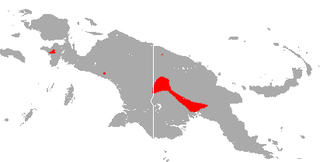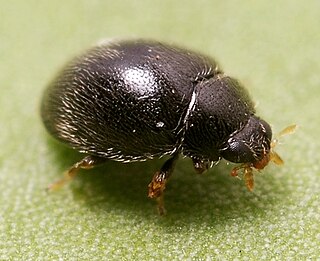
Cryptophagidae is a family of beetles with representatives found in all biogeographic realms. Members of this family are commonly called silken fungus beetles and both adults and larvae appear to feed exclusively on fungi although in a wide variety of habitats and situations, such as rotting wood and shed animal fur and feathers. These beetles vary from about 1 to 11 millimeters long, and usually have an oval body shape with a slight "waist".

Wollaston's roundleaf bat is a species of bat in the family Hipposideridae. It is found in West Papua, Indonesia and Papua New Guinea. It was named after the explorer Sandy Wollaston.

Aulonothroscus is a genus of small false click beetles in the family Throscidae. There are more than 20 described species in Aulonothroscus.

Curimopsis is a genus of pill beetles in the family Byrrhidae. There are more than 30 described species in Curimopsis.

Callicorixa is a genus of water boatmen in the family Corixidae. There are about nine described species in Callicorixa.

Stethorus is a genus of spider mite destroyers in the beetle family Coccinellidae. There are more than 40 described species in Stethorus.

Atomaria is a genus of silken fungus beetles in the family Cryptophagidae. There are more than 160 described species in Atomaria.
Atomaria stricticollis is a species of silken fungus beetle in the family Cryptophagidae. It is found in North America.
Atomaria ephippiata is a species of silken fungus beetle in the family Cryptophagidae. It is found in North America.
Atomaria nigrirostris is a species of silken fungus beetle in the family Cryptophagidae. It is found in Africa, Europe and Northern Asia, and North America.
Atomaria lederi is a species of silken fungus beetle in the family Cryptophagidae. It is found in Europe and Northern Asia, North America, and Southern Asia.
Atomaria vespertina is a species of silken fungus beetle in the family Cryptophagidae. It is found in North America and Europe.
Atomaria fuscata is a species of silken fungus beetle in the family Cryptophagidae. It is found in Europe and Northern Asia, North America, and Southern Asia.

Chelymorpha is a genus of tortoise beetles and hispines in the family Chrysomelidae. There are more than 70 described species in Chelymorpha.
Hypena atomaria, the speckled snout moth, is a species of moth in the family Erebidae.
Atomaria testacea is a species of silken fungus beetle in the family Cryptophagidae. It is found in Africa, Europe and Northern Asia, and North America.
Atomaria apicalis is a species of silken fungus beetle in the family Cryptophagidae. It is found in Europe and Northern Asia and North America.
Atomaria distincta is a species of silken fungus beetle in the family Cryptophagidae. It is found in North America.
Senna atomaria, the flor de San Jose, is a species of flowering plant in the family Fabaceae, native to Mexico, Central America, the Caribbean, Colombia, and Venezuela. A shrub or small tree, it is considered a multi-purpose species; fuel, wood, biomass, soil improvement, medicine, and ornament.







